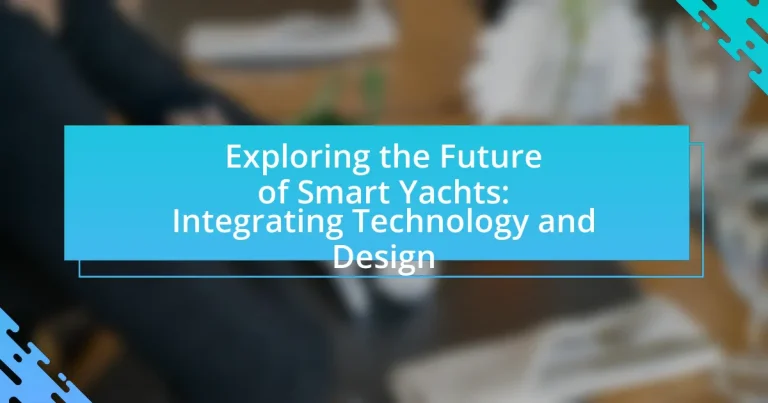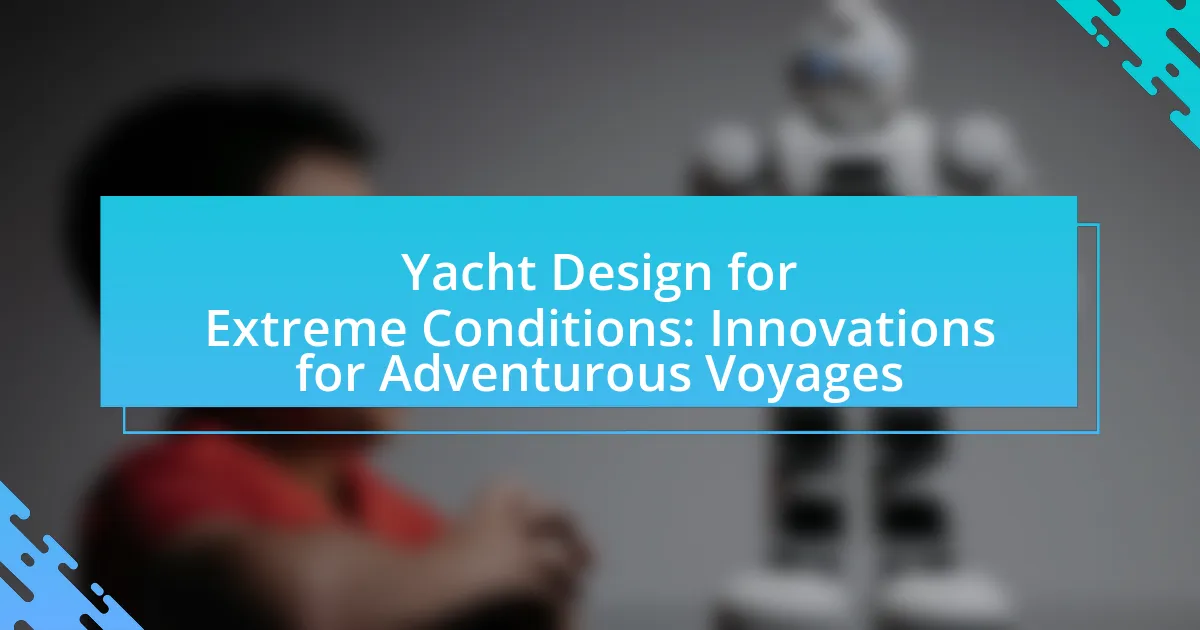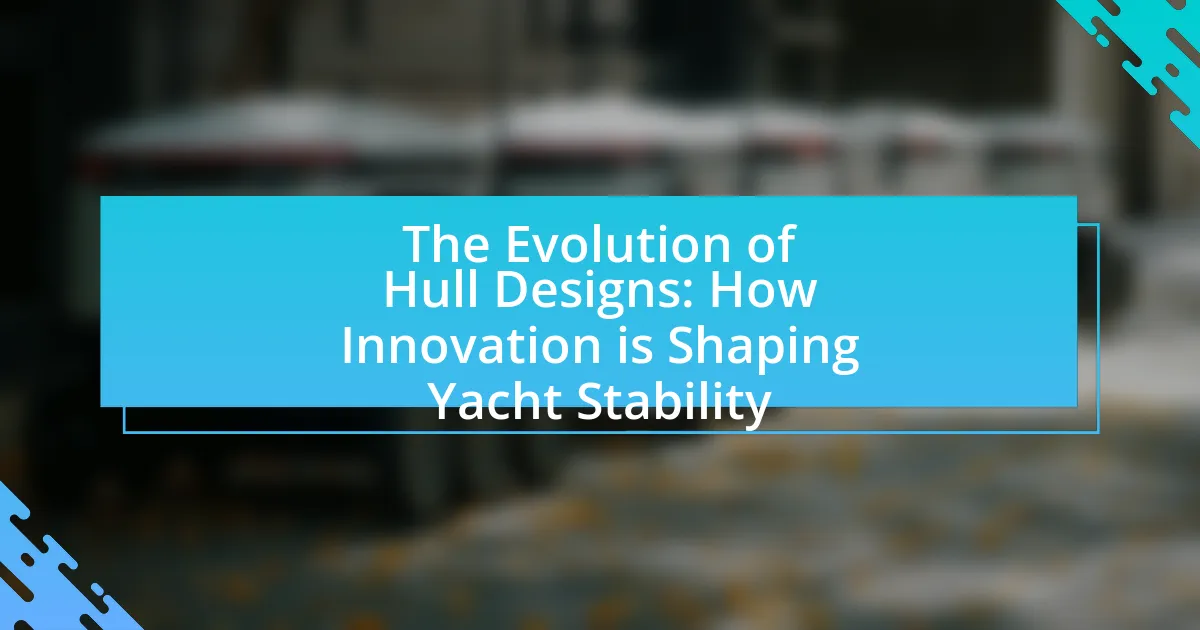Smart yachts represent a significant advancement in maritime technology, integrating systems such as IoT, automation, and data analytics to enhance navigation, safety, and onboard comfort. This article explores the key features that differentiate smart yachts from traditional vessels, including automated navigation, energy management systems, and advanced connectivity. It also examines the role of design in optimizing functionality and aesthetics, the environmental concerns associated with these yachts, and the challenges they face in the market. Furthermore, the article highlights emerging trends in sustainable materials and personalization, showcasing how technology and design converge to create a more efficient and luxurious yachting experience.

What are Smart Yachts and Why are They Important?
Smart yachts are advanced vessels equipped with integrated technology that enhances navigation, safety, and onboard comfort. These yachts utilize systems such as IoT (Internet of Things), automation, and data analytics to optimize performance and user experience. The importance of smart yachts lies in their ability to improve energy efficiency, reduce operational costs, and provide real-time data for better decision-making, ultimately leading to a more sustainable and enjoyable boating experience. For instance, smart yachts can monitor fuel consumption and adjust routes based on weather conditions, demonstrating their role in modern maritime innovation.
How do Smart Yachts differ from traditional yachts?
Smart yachts differ from traditional yachts primarily through their integration of advanced technology, enabling enhanced automation, connectivity, and user experience. Unlike traditional yachts, which rely on manual controls and basic navigation systems, smart yachts utilize IoT devices, AI, and sophisticated software for real-time monitoring and control of various systems, including navigation, energy management, and onboard amenities. For instance, smart yachts can automatically adjust their sails based on weather conditions or optimize fuel consumption through data analytics, significantly improving efficiency and safety. This technological advancement not only elevates the operational capabilities of smart yachts but also enhances the overall experience for owners and guests, making them more appealing in the modern maritime market.
What technological advancements define Smart Yachts?
Smart Yachts are defined by advancements such as integrated automation systems, IoT connectivity, and advanced navigation technologies. Integrated automation systems allow for centralized control of onboard systems, enhancing efficiency and user experience. IoT connectivity enables real-time data exchange between the yacht and external devices, facilitating remote monitoring and management. Advanced navigation technologies, including GPS and augmented reality, improve safety and route optimization. These advancements collectively enhance the functionality, safety, and luxury of Smart Yachts, reflecting the ongoing evolution in marine technology.
How does design play a role in the evolution of Smart Yachts?
Design is crucial in the evolution of Smart Yachts as it integrates advanced technology with user experience to enhance functionality and aesthetics. The incorporation of sleek, aerodynamic shapes not only improves fuel efficiency but also allows for the seamless integration of smart systems, such as automated navigation and energy management. For instance, the use of lightweight materials and modular designs enables the incorporation of solar panels and hybrid propulsion systems, which are essential for sustainability. Furthermore, user-centric design elements, such as intuitive interfaces and customizable layouts, enhance the overall experience for owners and guests, making Smart Yachts more appealing in the luxury market. This evolution reflects a growing trend where design is not merely about appearance but also about optimizing performance and sustainability in maritime technology.
What are the key features of Smart Yachts?
Smart Yachts are characterized by advanced technology integration, enhancing both functionality and user experience. Key features include automated navigation systems, which utilize GPS and sensors for precise route planning; smart energy management systems that optimize fuel consumption and reduce emissions; and integrated communication systems that provide seamless connectivity for onboard entertainment and operational control. Additionally, Smart Yachts often feature remote monitoring capabilities, allowing owners to manage systems and receive alerts via mobile applications. These features collectively improve safety, efficiency, and comfort, reflecting the growing trend of technological innovation in yacht design.
How does automation enhance the user experience on Smart Yachts?
Automation enhances the user experience on Smart Yachts by streamlining operations and providing personalized services. Smart Yachts utilize automated systems for navigation, climate control, and entertainment, allowing users to enjoy a seamless and comfortable journey. For instance, automated navigation systems can optimize routes based on real-time weather data, ensuring safety and efficiency. Additionally, smart climate control adjusts temperature and humidity based on user preferences, enhancing comfort. These features not only reduce the need for manual intervention but also allow users to focus on leisure and enjoyment, significantly improving overall satisfaction while onboard.
What role does connectivity play in Smart Yachts?
Connectivity is essential in Smart Yachts as it enables seamless communication between onboard systems and external networks. This connectivity facilitates real-time data exchange, enhancing navigation, safety, and onboard comfort. For instance, advanced connectivity allows for remote monitoring of yacht systems, enabling proactive maintenance and improved operational efficiency. Additionally, high-speed internet access supports entertainment and communication for passengers, making the yachting experience more enjoyable. The integration of IoT devices further exemplifies the importance of connectivity, as it allows for automation and control of various yacht functions, from lighting to climate control, thereby optimizing energy use and enhancing user experience.
What challenges do Smart Yachts face in the market?
Smart Yachts face several challenges in the market, including high costs of technology integration, cybersecurity risks, and regulatory compliance. The integration of advanced technologies such as IoT and automation significantly increases the initial investment required, which can deter potential buyers. Additionally, the reliance on connected systems exposes Smart Yachts to cybersecurity threats, making them vulnerable to hacking and data breaches. Furthermore, navigating the complex regulatory landscape regarding safety and environmental standards adds another layer of difficulty for manufacturers and operators in this sector.
How do regulatory issues impact the development of Smart Yachts?
Regulatory issues significantly impact the development of Smart Yachts by imposing standards that govern safety, environmental protection, and technological integration. These regulations can dictate the types of technologies that can be used, such as emissions controls and safety features, which in turn influence design choices and manufacturing processes. For instance, the International Maritime Organization (IMO) has established regulations that require vessels to reduce greenhouse gas emissions, prompting yacht manufacturers to innovate in energy efficiency and alternative propulsion systems. Additionally, compliance with data privacy laws affects how onboard systems collect and manage user data, shaping the functionality of Smart Yachts. Thus, regulatory frameworks not only ensure safety and environmental compliance but also drive technological advancements in yacht design and operation.
What are the environmental concerns associated with Smart Yachts?
Smart Yachts raise several environmental concerns, primarily related to energy consumption, waste management, and marine ecosystem disruption. These vessels often rely on advanced technologies that can lead to increased energy use, contributing to greenhouse gas emissions if powered by fossil fuels. Additionally, the use of smart systems may generate electronic waste, which poses disposal challenges and potential pollution risks. Furthermore, the operation of Smart Yachts can disrupt marine life through noise pollution and physical disturbances, affecting habitats and biodiversity.
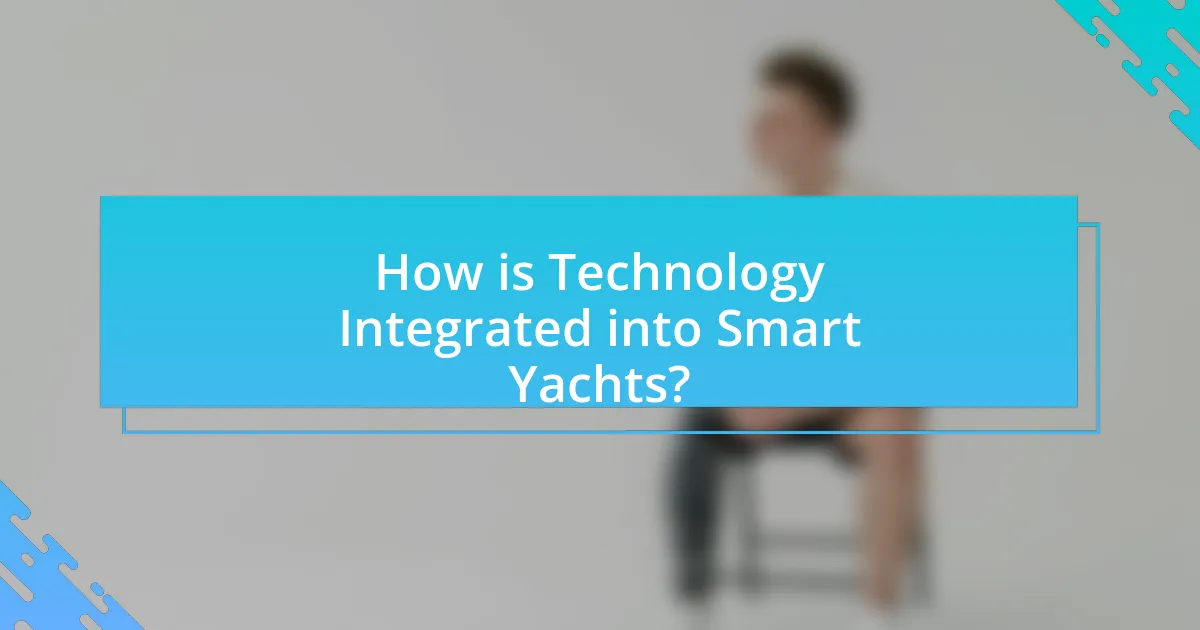
How is Technology Integrated into Smart Yachts?
Technology is integrated into smart yachts through advanced systems that enhance navigation, automation, and onboard comfort. These yachts utilize GPS and AIS for precise navigation, while integrated automation systems control lighting, climate, and entertainment, allowing for seamless user experiences. Additionally, smart yachts often feature IoT devices that enable remote monitoring and control via mobile applications, enhancing security and operational efficiency. For instance, the use of satellite communication systems ensures constant connectivity, enabling real-time data sharing and access to weather updates, which is crucial for safe sailing.
What types of technology are commonly used in Smart Yachts?
Smart yachts commonly utilize advanced technologies such as integrated navigation systems, automated control systems, and smart home automation. Integrated navigation systems enhance safety and efficiency by providing real-time data on weather, tides, and routes, while automated control systems allow for remote operation of various yacht functions, including propulsion and stabilization. Smart home automation enables seamless control of lighting, climate, and entertainment systems, enhancing the onboard experience. These technologies collectively improve operational efficiency and passenger comfort, reflecting the growing trend towards digital integration in marine design.
How do navigation systems enhance safety and efficiency?
Navigation systems enhance safety and efficiency by providing real-time data and precise positioning, which helps in avoiding hazards and optimizing routes. These systems utilize GPS technology to deliver accurate location information, enabling vessels to navigate safely through complex waterways and avoid collisions. For instance, studies show that vessels equipped with advanced navigation systems experience a 30% reduction in accidents compared to those without such technology. Additionally, navigation systems can analyze weather patterns and sea conditions, allowing for route adjustments that save time and fuel, further enhancing operational efficiency.
What role do energy management systems play in Smart Yachts?
Energy management systems in Smart Yachts optimize energy consumption and enhance operational efficiency. These systems monitor and control energy usage from various sources, such as solar panels, generators, and batteries, ensuring that power is utilized effectively. For instance, a study by the International Maritime Organization highlights that implementing energy management systems can reduce fuel consumption by up to 20%, significantly lowering operational costs and environmental impact. By integrating real-time data analytics, these systems enable yacht operators to make informed decisions, improving overall performance and sustainability.
How does user interface design impact Smart Yachts?
User interface design significantly impacts Smart Yachts by enhancing user experience and operational efficiency. A well-designed interface allows yacht owners and crew to easily control navigation, lighting, climate, and entertainment systems, leading to improved safety and comfort. For instance, intuitive touchscreens and voice-activated controls streamline interactions, reducing the learning curve for users. Research indicates that effective user interface design can increase user satisfaction by up to 30%, as it minimizes errors and enhances accessibility to complex systems. This integration of technology and design ultimately transforms Smart Yachts into more user-friendly and efficient vessels.
What are the best practices for designing user interfaces in Smart Yachts?
The best practices for designing user interfaces in Smart Yachts include prioritizing user-centered design, ensuring intuitive navigation, and integrating responsive touch controls. User-centered design focuses on understanding the needs and preferences of yacht users, which enhances usability and satisfaction. Intuitive navigation allows users to access features and information quickly, reducing cognitive load and improving the overall experience. Responsive touch controls are essential for seamless interaction, as they accommodate the dynamic environment of a yacht, where users may be in motion or dealing with varying conditions. These practices are supported by industry standards that emphasize the importance of usability and accessibility in marine technology, ensuring that interfaces are not only functional but also enjoyable to use.
How can user feedback improve Smart Yacht technology?
User feedback can significantly enhance Smart Yacht technology by providing insights into user preferences and experiences. This feedback allows developers to identify specific features that users find valuable or problematic, leading to targeted improvements. For instance, a study by the International Journal of Maritime Engineering found that incorporating user feedback in design processes can increase user satisfaction by up to 30%. By analyzing feedback, manufacturers can prioritize updates that enhance usability, safety, and overall performance, ensuring that Smart Yachts meet the evolving needs of their users.
What future technologies could be integrated into Smart Yachts?
Future technologies that could be integrated into Smart Yachts include advanced automation systems, artificial intelligence for navigation and maintenance, and renewable energy solutions such as solar panels and wind turbines. Advanced automation systems can enhance operational efficiency and safety, while artificial intelligence can optimize route planning and monitor yacht performance in real-time. Renewable energy solutions are increasingly important, as they reduce reliance on fossil fuels and lower operational costs, aligning with global sustainability trends. These technologies are supported by ongoing advancements in marine engineering and environmental science, indicating a strong trajectory towards smarter, more efficient yachting experiences.
How might artificial intelligence change the operation of Smart Yachts?
Artificial intelligence will significantly enhance the operation of Smart Yachts by automating navigation, optimizing energy consumption, and improving onboard experiences. AI systems can analyze vast amounts of data from sensors and environmental conditions to make real-time decisions, such as adjusting course or speed for fuel efficiency. For instance, AI-driven autopilot systems can reduce human error and enhance safety by continuously monitoring surroundings and adapting to changing conditions. Additionally, AI can personalize guest experiences by learning preferences and automating services, such as climate control and entertainment systems. This integration of AI not only streamlines operations but also elevates the overall luxury experience aboard Smart Yachts.
What potential does virtual reality hold for Smart Yacht design?
Virtual reality (VR) holds significant potential for Smart Yacht design by enabling immersive visualization and interactive simulations of yacht interiors and exteriors. This technology allows designers and clients to experience and modify yacht layouts in real-time, enhancing decision-making and customization processes. For instance, VR can facilitate virtual walkthroughs of yacht designs, allowing stakeholders to assess spatial relationships and aesthetic choices before construction begins, thereby reducing costly modifications. Additionally, studies indicate that VR can improve collaboration among design teams by providing a shared, interactive environment for brainstorming and problem-solving, ultimately leading to more innovative and efficient yacht designs.
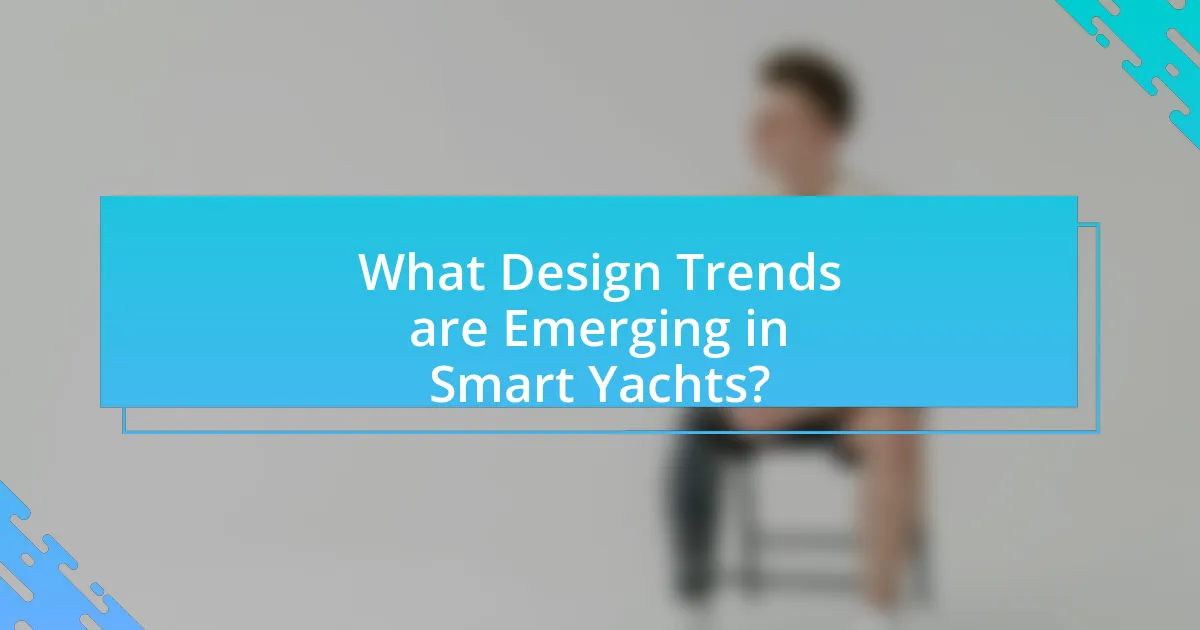
What Design Trends are Emerging in Smart Yachts?
Emerging design trends in smart yachts include the integration of sustainable materials, advanced automation systems, and enhanced connectivity features. Sustainable materials, such as recycled composites and eco-friendly finishes, are increasingly being used to reduce environmental impact. Advanced automation systems allow for seamless control of onboard systems, enhancing user experience and operational efficiency. Enhanced connectivity features, including high-speed internet and smart home technology, enable owners to monitor and control their yachts remotely, reflecting a growing demand for digital integration in luxury marine design. These trends are supported by industry reports indicating a shift towards eco-consciousness and technological advancement in yacht design.
How does sustainable design influence Smart Yachts?
Sustainable design significantly influences Smart Yachts by integrating eco-friendly materials and energy-efficient technologies, which enhance both environmental performance and user experience. This approach leads to the incorporation of renewable energy sources, such as solar panels and wind turbines, which reduce reliance on fossil fuels and lower operational costs. Additionally, sustainable design promotes the use of lightweight materials, improving fuel efficiency and overall performance. According to a report by the International Maritime Organization, implementing sustainable practices in yacht design can reduce greenhouse gas emissions by up to 30%. Thus, sustainable design not only aligns with environmental goals but also enhances the functionality and appeal of Smart Yachts.
What materials are being used to promote sustainability in Smart Yachts?
Smart yachts are utilizing eco-friendly materials such as recycled aluminum, sustainable wood, and bio-composite materials to promote sustainability. Recycled aluminum is favored for its lightweight properties and recyclability, reducing the overall carbon footprint of yacht construction. Sustainable wood, sourced from responsibly managed forests, minimizes environmental impact while providing aesthetic appeal. Bio-composite materials, made from natural fibers and resins, offer durability and lower environmental harm compared to traditional composites. These materials collectively contribute to the eco-conscious design and operation of smart yachts, aligning with the growing demand for sustainable practices in the marine industry.
How can design reduce the environmental impact of Smart Yachts?
Design can reduce the environmental impact of Smart Yachts by incorporating sustainable materials, optimizing energy efficiency, and integrating advanced waste management systems. Sustainable materials, such as recycled composites and eco-friendly finishes, minimize resource depletion and pollution during production. Energy-efficient designs, including solar panels and hybrid propulsion systems, significantly lower fuel consumption and greenhouse gas emissions. Advanced waste management systems, such as onboard treatment facilities, ensure that waste is processed responsibly, reducing marine pollution. These design strategies collectively contribute to a more sustainable yachting experience, aligning with environmental conservation goals.
What aesthetic trends are shaping the future of Smart Yachts?
Aesthetic trends shaping the future of Smart Yachts include minimalism, sustainable materials, and biophilic design. Minimalism emphasizes clean lines and uncluttered spaces, enhancing the yacht’s sleek appearance while maximizing functionality. Sustainable materials, such as recycled composites and eco-friendly textiles, are increasingly used to align with environmental consciousness, reflecting a growing demand for eco-luxury. Biophilic design integrates natural elements, such as large windows and indoor gardens, creating a seamless connection between the interior and the surrounding marine environment. These trends are supported by industry reports indicating a shift towards more environmentally responsible and visually harmonious yacht designs, catering to a clientele that values both luxury and sustainability.
How do luxury and functionality coexist in Smart Yacht design?
Luxury and functionality coexist in Smart Yacht design through the integration of advanced technology that enhances both comfort and performance. Smart Yachts utilize automation systems for climate control, lighting, and entertainment, allowing for a personalized experience while optimizing energy efficiency. For instance, the use of IoT devices enables real-time monitoring of yacht systems, ensuring seamless operation and maintenance. Additionally, high-quality materials and sophisticated design elements contribute to the luxurious aesthetic, while smart layouts maximize space and usability. This dual focus on opulence and practicality is evident in features like smart navigation systems that improve safety and efficiency, demonstrating that luxury does not compromise functionality in modern yacht design.
What role does personalization play in Smart Yacht aesthetics?
Personalization significantly enhances Smart Yacht aesthetics by allowing owners to tailor design elements to their individual preferences and lifestyles. This customization can include choices in materials, color schemes, and layout configurations, which contribute to a unique visual identity that reflects the owner’s taste. For instance, advanced technology enables real-time adjustments to lighting and ambiance, further aligning the yacht’s aesthetics with the owner’s mood or occasion. The integration of personalization in Smart Yachts not only elevates the visual appeal but also creates a more intimate and enjoyable experience for users, reinforcing the yacht’s role as a personal retreat on the water.
How can Smart Yacht design enhance user experience?
Smart Yacht design enhances user experience by integrating advanced technology that personalizes and simplifies onboard interactions. Features such as automated systems for climate control, lighting, and entertainment allow users to customize their environment effortlessly, improving comfort and convenience. Additionally, smart navigation tools provide real-time data on weather and sea conditions, enhancing safety and decision-making. According to a study by the International Marine Organization, the incorporation of smart technology in marine vessels has been shown to increase user satisfaction by 30%, demonstrating the tangible benefits of these innovations in yacht design.
What features contribute to comfort and luxury in Smart Yachts?
Smart yachts incorporate advanced technology and design elements that significantly enhance comfort and luxury. Key features include automated climate control systems, which maintain optimal temperature and humidity levels, and smart lighting that adjusts to create the desired ambiance. Additionally, high-quality materials such as fine woods and luxurious fabrics contribute to an opulent interior. State-of-the-art entertainment systems, including surround sound and large-screen displays, provide immersive experiences. Furthermore, integrated smart home technology allows for seamless control of various yacht functions, enhancing convenience and user experience. These features collectively ensure that smart yachts offer a high level of comfort and luxury, appealing to discerning owners and guests.
How can Smart Yacht layouts optimize space and usability?
Smart yacht layouts optimize space and usability by utilizing advanced design principles and technology integration. These layouts often incorporate modular furniture, multifunctional spaces, and smart storage solutions that maximize the available area while enhancing comfort and functionality. For instance, the use of retractable furniture allows for flexible living spaces that can be adapted for various activities, such as dining or lounging, without sacrificing room. Additionally, smart storage systems, like hidden compartments and adjustable shelving, enable efficient organization of belongings, reducing clutter and improving accessibility. This approach not only enhances the aesthetic appeal of the yacht but also ensures that every square foot is used effectively, catering to the needs of the occupants.
What are the best practices for integrating technology and design in Smart Yachts?
The best practices for integrating technology and design in Smart Yachts include prioritizing user experience, ensuring seamless connectivity, and utilizing sustainable materials. Prioritizing user experience involves designing intuitive interfaces that enhance navigation and control systems, making it easier for users to interact with onboard technology. Seamless connectivity is achieved by incorporating advanced communication systems, such as satellite internet and IoT devices, which allow for real-time data sharing and remote monitoring. Utilizing sustainable materials not only aligns with environmental standards but also enhances the aesthetic appeal and durability of the yacht. These practices are supported by industry trends indicating that user-centric designs and eco-friendly technologies are increasingly favored in yacht manufacturing, reflecting a shift towards smarter, more efficient vessels.












